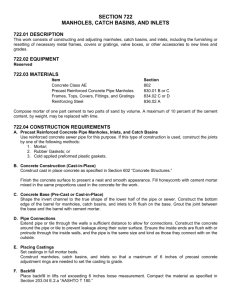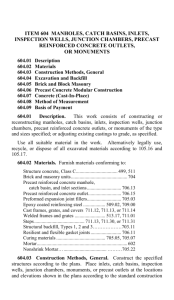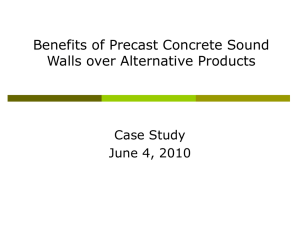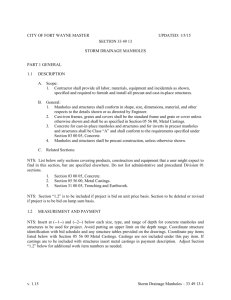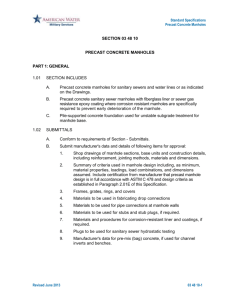item d-751 manholes, catch basins, inlets and
advertisement
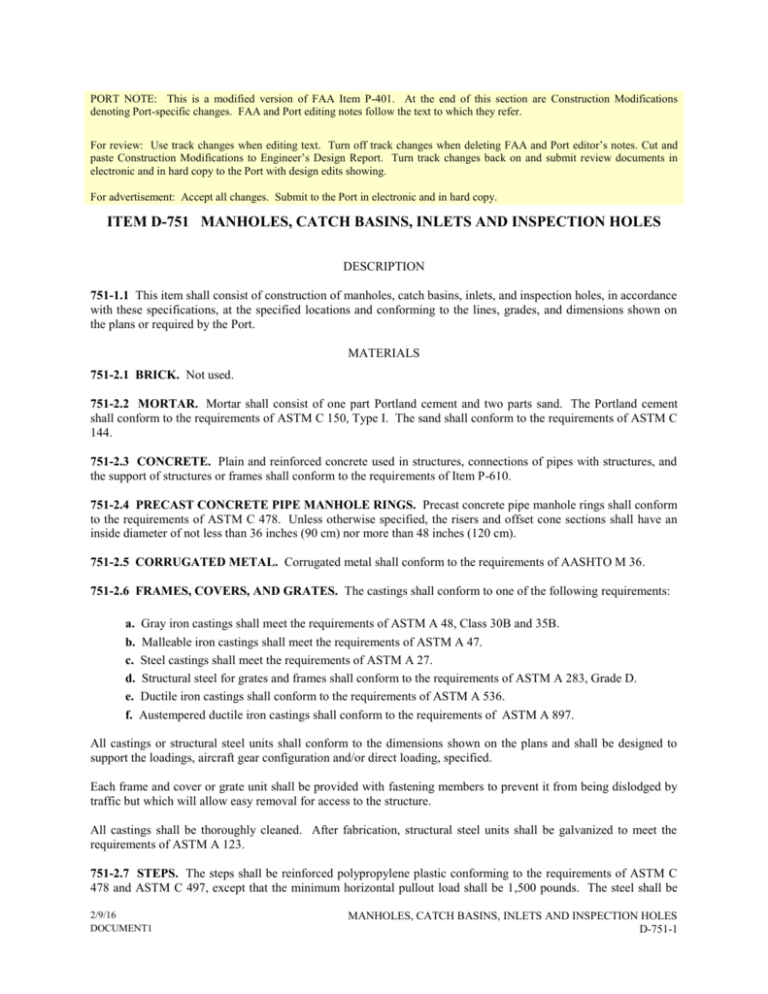
PORT NOTE: This is a modified version of FAA Item P-401. At the end of this section are Construction Modifications denoting Port-specific changes. FAA and Port editing notes follow the text to which they refer. For review: Use track changes when editing text. Turn off track changes when deleting FAA and Port editor’s notes. Cut and paste Construction Modifications to Engineer’s Design Report. Turn track changes back on and submit review documents in electronic and in hard copy to the Port with design edits showing. For advertisement: Accept all changes. Submit to the Port in electronic and in hard copy. ITEM D-751 MANHOLES, CATCH BASINS, INLETS AND INSPECTION HOLES DESCRIPTION 751-1.1 This item shall consist of construction of manholes, catch basins, inlets, and inspection holes, in accordance with these specifications, at the specified locations and conforming to the lines, grades, and dimensions shown on the plans or required by the Port. MATERIALS 751-2.1 BRICK. Not used. 751-2.2 MORTAR. Mortar shall consist of one part Portland cement and two parts sand. The Portland cement shall conform to the requirements of ASTM C 150, Type I. The sand shall conform to the requirements of ASTM C 144. 751-2.3 CONCRETE. Plain and reinforced concrete used in structures, connections of pipes with structures, and the support of structures or frames shall conform to the requirements of Item P-610. 751-2.4 PRECAST CONCRETE PIPE MANHOLE RINGS. Precast concrete pipe manhole rings shall conform to the requirements of ASTM C 478. Unless otherwise specified, the risers and offset cone sections shall have an inside diameter of not less than 36 inches (90 cm) nor more than 48 inches (120 cm). 751-2.5 CORRUGATED METAL. Corrugated metal shall conform to the requirements of AASHTO M 36. 751-2.6 FRAMES, COVERS, AND GRATES. The castings shall conform to one of the following requirements: a. Gray iron castings shall meet the requirements of ASTM A 48, Class 30B and 35B. b. Malleable iron castings shall meet the requirements of ASTM A 47. c. Steel castings shall meet the requirements of ASTM A 27. d. Structural steel for grates and frames shall conform to the requirements of ASTM A 283, Grade D. e. Ductile iron castings shall conform to the requirements of ASTM A 536. f. Austempered ductile iron castings shall conform to the requirements of ASTM A 897. All castings or structural steel units shall conform to the dimensions shown on the plans and shall be designed to support the loadings, aircraft gear configuration and/or direct loading, specified. Each frame and cover or grate unit shall be provided with fastening members to prevent it from being dislodged by traffic but which will allow easy removal for access to the structure. All castings shall be thoroughly cleaned. After fabrication, structural steel units shall be galvanized to meet the requirements of ASTM A 123. 751-2.7 STEPS. The steps shall be reinforced polypropylene plastic conforming to the requirements of ASTM C 478 and ASTM C 497, except that the minimum horizontal pullout load shall be 1,500 pounds. The steel shall be 2/9/16 DOCUMENT1 MANHOLES, CATCH BASINS, INLETS AND INSPECTION HOLES D-751-1 Grade 60, 1/2 inch (13 mm) deformed reinforcing bar conforming to ASTM A 615. The polypropylene shall conform to ASTM D 4101. The entire polypropylene material surrounding the reinforced steel bar shall be encased monolithically with a minimum thickness over the steel of 1/16 inch (1.6 mm). Steps or ladder bars made of gray or malleable cast iron or galvanized steel are acceptable alternatives. If constructed of iron or steel, the steps shall be the same size, length, and shape shown on the plans. Steel steps not galvanized shall be given a coat of bituminous paint. 751-2.8 ANTI-SEIZE LUBRICANT. Bolts associated with installation shall be applied with anti-seize lubricant such as Never-Seez, or equal, prior to installation. 751-2.9 BEDDING. Bedding shall be 1"-0" (25-0 mm) or 3/4"-0" (19-0 mm) crushed aggregate that meets the requirements of ODOT Section 02630. 751-2.10 CONFINED SPACE SIGNAGE. approximately 10" x 14" (250 x 350 mm). Confined space signs will be furnished by the Port and are 751-2.11 ENGINEERING SHORING SYSTEM. An engineering shoring system shall be required to provide temporary earth support for excavations greater than 6 feet (2 meters) in depth. A support plan prepared and sealed by a State of Oregon licensed professional engineer shall address the following: a. Details of shoring system to protect workers from hazards of caving ground and to prevent detrimental settlement or lateral movement of existing facilities, adjacent property, or completed work. b. Design calculations, including design criteria, analysis assumptions, construction sequence requirements, and detailed design for each system and structural element of proposed shoring system. c. Methods and sequencing of installing temporary earth support. d. Proposed locations of stockpiled excavated material. e. Minimum lateral distance from the crest of slopes for vehicles and stockpiled excavated materials. f. Anticipated difficulties and proposed resolution(s). CONSTRUCTION METHODS 751-3.1 UNCLASSIFIED EXCAVATION. a. The Contractor shall do all excavation for structures and structure footings to the lines and grades or elevations, shown on the plans, or as staked by the Port. The excavation shall be of sufficient size to permit the placing of the full width and length of the structure or structure footings shown. The elevations of the bottoms of footings, as shown on the plans, shall be considered as approximately only; and the Port may order, in writing, changes in dimensions or elevations of footings necessary to secure a satisfactory foundation. b. Boulders, logs, or any other objectionable material encountered in excavation shall be removed. All rock or other hard foundation material shall be cleaned of all loose material and cut to a firm surface either level, stepped, or serrated, as directed by the Port. All seams or crevices shall be cleaned out and grouted. All loose and disintegrated rock and thin strata shall be removed. When concrete is to rest on a surface other than rock, special care shall be taken not to disturb the bottom of the excavation, and excavation to final grade shall not be made until just before the concrete or reinforcing is to be placed. c. The Contractor shall do all bracing, sheathing, or shoring necessary to implement and protect the excavation and the structure as required for safety or conformance to governing laws. The cost of bracing, sheathing, or shoring shall be included in the unit price bid for the structure. MANHOLES, CATCH BASINS, INLETS AND INSPECTION HOLES D-751-2 2/9/16 DOCUMENT1 d. Unless otherwise provided, bracing, sheathing, or shoring involved in the construction of this item shall be removed by the Contractor after the completion of the structure. Removal shall be effected in a manner that will not disturb or mar finished masonry. The cost of removal shall be included in the unit price bid for the structure. e. After each excavation is completed, the Contractor shall notify the Port to that effect; and concrete or reinforcing steel shall be placed after the Port has approved the depth of the excavation and the character of the foundation material. 751-3.2 BRICK STRUCTURES. Not used. 751-3.3 CONCRETE STRUCTURES. Concrete structures shall be built on prepared foundations, conforming to the dimensions and form indicated on the plans. The construction shall conform to the requirements specified in Item P-610. Any reinforcement required shall be placed as indicated on the plans and shall be approved by the Port before the concrete is poured. All invert channels shall be constructed and shaped accurately so as to be smooth, uniform, and cause minimum resistance to flowing water. The interior bottom shall be sloped downward toward the outlet. 751-3.4 PRECAST CONCRETE PIPE STRUCTURES. Precast concrete pipe structures shall be constructed on prepared or previously placed slab foundations and shall conform to the dimensions and locations shown on the plans. All precast concrete pipe sections necessary to build a completed structure shall be furnished. The different sections shall fit together readily, and all jointing and connections shall be cemented with mortar. The top of the upper precast concrete pipe member shall be suitably formed and dimensioned to receive the metal frame and cover or grate, or other cap, as required. Provision shall be made for any connections for lateral pipe, including drops and leads that may be installed in the structure. The flow lines shall be smooth, uniform, and cause minimum resistance to flow. The metal steps that are embedded or built into the side walls shall be aligned and placed at vertical intervals of 12 inches (300 mm). When a metal ladder replaces the steps, it shall be securely fastened into position. 751-3.5 CORRUGATED METAL STRUCTURES. Corrugated metal structures shall be constructed on prepared foundations, conforming to the dimensions and locations as shown on the plans. The structures shall be prefabricated. standard or special fittings shall be furnished to provide pipe connections or branches of correct dimensions. The connections or branches shall be of sufficient length to accommodate connecting bands. The fittings shall be welded in place to the metal structures. When indicated, the structures shall be placed on a reinforced concrete base. The top of the metal structure shall be designed so that either a concrete slab or metal collar may be attached to which can be fastened a standard metal frame and grate or cover. Steps or ladders shall be furnished as shown on the plans. PORT NOTE: Corrugated metal structures are not typically preferred but may be necessary depending on the project. 751-3.6 INLET AND OUTLET PIPES. Inlet and outlet pipes shall extend through the walls of the structures for a sufficient distance beyond the outside surface to allow for connections but shall be cut off flush with the wall on the inside surface, unless otherwise directed. For concrete structures, the mortar shall be placed around these pipes so as to form a tight, neat connection. Provide a flex joint within 18 inches of the structure face. 751-3.7 PLACEMENT AND TREATMENT OF CASTINGS, FRAMES, AND FITTINGS. All castings, frames, and fittings shall be placed in the positions indicated on the plans or as directed by the Port, and shall be set true to line and to correct elevation. If frames or fittings are to be set in concrete or cement mortar, all anchors or bolts shall be in place and position before the concrete or mortar is placed. The unit shall not be disturbed until the mortar or concrete has set. When frames or fittings are to be placed upon previously constructed masonry, the bearing surface or masonry shall be brought true to line and grade and shall present an even bearing surface in order that the entire face or back of the unit will come in contact with the masonry. The unit shall be set in mortar beds and anchored to the masonry as indicated on the plans or as directed and approved by the Port. All units shall set firm and secure. 2/9/16 DOCUMENT1 MANHOLES, CATCH BASINS, INLETS AND INSPECTION HOLES D-751-3 After the frames or fittings have been set in final position and the concrete or mortar has been allowed to harden for 7 days, then the grates or covers shall be placed and fastened down. 751-3.8 INSTALLATION OF STEPS. The steps shall be installed as indicated on the plans or as directed by the Port. When the steps are to be set in concrete, they shall be placed and secured in position before the concrete is poured. When the steps are installed in brick masonry, they shall be placed as the masonry is being built. The steps shall not be disturbed or used until the concrete or mortar has hardened for at least 7 days. After this period has elapsed, the steps shall be cleaned and painted, unless they have been galvanized. When steps are required with precast concrete pipe structures, they shall be cast into the sides of the pipe at the time the pipe sections are manufactured or set in place after the structure is erected by drilling holes in the concrete and cementing the steps in place. When steps are required with corrugated metal structures, they shall be welded into aligned position at a vertical spacing of 12 inches (300 mm). In lieu of steps, prefabricated ladders may be installed. In the case of brick or concrete structures, the ladder shall be held in place by grouting the supports in drilled holes. In the case of metal structures, the ladder shall be secured by welding the top support and grouting the bottom support into drilled holes in the foundation or as directed. 751-3.9 BACKFILLING. a. After a structure has been completed, the area around it shall be filled with approved material, in horizontal layers not to exceed 8 inches (200 mm) in loose depth, and compacted to the density required in Item P-152. Each layer shall be deposited all around the structure to approximately the same elevation. The top of the fill shall meet the elevation shown on the plans or as directed by the Port. b. Backfilling shall not be placed against any structure until permission is given by the Port. In the case of concrete, such permission shall not be given until the concrete has been in place 7 days, or until tests made by the laboratory under supervision of the Port establish that the concrete has attained sufficient strength to provide a factor of safety against damage or strain in withstanding any pressure created by the backfill or the methods used in placing it. c. Backfill shall not be measured for direct payment. Performance of this work shall be considered on obligation of the Contractor covered under the contract unit price for the structure involved. ************************************************************* When structures are located within the runway safety area, POFA, RPZ, etc., the elevation of the structures shall be set to meet the grading requirements of these areas. ************************************************************* 751-3.10 CLEANING AND RESTORATION OF SITE. After the backfill is completed, the Contractor shall dispose of all surplus material, dirt, and rubbish from the site. Surplus dirt may be deposited in embankments, shoulders, or as ordered by the Port. The Contractor shall restore all disturbed areas to their original condition. After all work is completed, the Contractor shall remove all tools and equipment, leaving the entire site free, clear, and in good condition. 751-3.11 ADJUSTING EXISTING STRUCTURES. Where shown on the drawings or directed by the Port, the existing manholes or inlets shall be adjusted to the grade indicated or otherwise directed. a. Adjustment of Existing Manholes. MANHOLES, CATCH BASINS, INLETS AND INSPECTION HOLES D-751-4 2/9/16 DOCUMENT1 (1) Metal Steps and Ladders. If existing manholes or similar structures have metal steps or metal ladders, provide new steps or new ladder extensions in the adjusted structure. (2) Concrete and Masonry Manholes. Manholes may be raised or lowered as specified below: (a) Minor adjustments of manholes are those requiring addition or removal of precast grade rings or metal rings as approved. (b) Major adjustments of manholes are those infringing into the cone or flattop section. Remove the cone or flattop, add or remove sections, and replace the cone or flat top. Use risers to attain desired grade. (3) Precast sections removed in the adjustment may be reused in other adjustments or in new construction provided they are in good condition and conform to project requirements. Precast items not used in the project become the property of the Contractor. (4) Raising Tops of Manholes. The top of the manhole may be raised using riser rings or by neck reconstruction. Do not exceed 18 inches total distance from the top of the frame at its adjusted grade to the top of the cone. (5) Lowering Tops of Manholes. When adjustment does not require removal of the cone or flattop, proceed as follows: (a) Cut off or remove structure to elevation below that established for bottom of metal frame or cover. (b) Build up with mortar, concrete, brick or concrete blocks to the required elevation. (c) Set the frame and cover in accordance with section 3.7 of this specification. b. Adjustment of Existing Concrete Catch Basins and Inlets. (1) Precast sections may be added or removed as required to obtain proper grade. (2) Precast structures may be raised using precast sections providing the following: (a) The material conforms to the requirements of the existing structure. (b) Sections are set and joined to each other and to existing sections. (c) Uniform bearing of bearing surfaces is assured. (d) Positive safeguards are made against displacement under loading including joining of precast sections to the structure with exposed existing reinforcement and joining of new frame to structure with anchor studs. c. Adjustment of Boxes, Cleanout Lids, and Similar Structures. Boxes, lids and other similar structures may be raised and lowered given: (1) The entire structure is reset on a firm foundation. (2) Placement of like material extensions as required to enclose or protect the structures’ contents. (3) Placement of precast box extensions or cast-in-place concrete. 2/9/16 DOCUMENT1 MANHOLES, CATCH BASINS, INLETS AND INSPECTION HOLES D-751-5 d. Finish Grade. Existing manholes, catch basins, inlets, boxes, and similar structures shall be adjusted to the grade indicated or otherwise directed. The final grade of the adjusted structures shall not vary from the final pavement surface grade by more than 1/4 inch in 12 feet. e. Confined Space Signage. Ensure existing confined space signs remain intact or are replaced and properly numbered if damaged while making adjustments. 751-3.12 INSTALLATION OF CONFINED SPACE SIGNAGE. The Contractor shall permanently attach Portfurnished confined space signage using Hilti anchors and equipment, or equal, in accordance with the drawings. The Port-furnished confined space number is to be written on the sign using a permanent marker in a clear, legible manner. Submit to the Port the physical description, in writing, for each confined space. Description shall include the inner dimensions of the confined space and the size of any pipes attached to the confined space. Installation of confined space signage shall be considered incidental to the work of this item. METHOD OF MEASUREMENT 751-4.1 751-4.2 751-4.3 751-4.4 751-4.5 751-4.6 751-4.7 751-4.8 751-4.9 751-4.10 751-4.11 751-4.12 751-4.13 751-4.14 48-INCH MANHOLE, TYPE A 48-INCH MANHOLE, TYPE B 60-INCH MANHOLE, TYPE A 72-INCH MANHOLE, TYPE A 84-INCH MANHOLE, TYPE A CONNECTION TO EXISTING MANHOLE OR INLET INLET, TYPE A INLET, TYPE B CONCRETE FIELD INLET MANHOLE ADJUSTMENT MANHOLE FRAME AND COVER REPLACEMENT EXISTING FIRE HYDRANT ADJUSTMENT EXISTING WATER VALVE ADJUSTMENT CLEANOUT Items listed above shall be measured by the unit. BASIS OF PAYMENT 751-5.1 751-5.2 751-5.3 751-5.4 751-5.5 751-5.6 751-5.7 751-5.8 751-5.9 751-5.10 751-5.11 751-5.12 751-5.13 751-5.14 48-INCH MANHOLE, TYPE A 48-INCH MANHOLE, TYPE B 60-INCH MANHOLE, TYPE A 72-INCH MANHOLE, TYPE A 84-INCH MANHOLE, TYPE A CONNECTION TO EXISTING MANHOLE OR INLET INLET, TYPE A INLET, TYPE B CONCRETE FIELD INLET MANHOLE ADJUSTMENT MANHOLE FRAME AND COVER REPLACEMENT EXISTING FIRE HYDRANT ADJUSTMENT EXISTING WATER VALVE ADJUSTMENT CLEANOUT MANHOLES, CATCH BASINS, INLETS AND INSPECTION HOLES D-751-6 2/9/16 DOCUMENT1 The accepted quantities of structures and adjustment items listed above will be paid for at the contract unit price per each, complete and in place. The price to connect to an existing item shall include the cost of the appropriate sized core-drilled hole at each location. This price will be full compensation for furnishing all materials and for all preparation, excavation, backfilling and placing of the materials; furnishing and installation of such specials and connections to pipes and other structures as may be required to complete the item as shown on the plans; and for all labor equipment, tools and incidentals necessary to complete the structure. MATERIAL REQUIREMENT ASTM A 27 Steel Castings, Carbon, for General Application ASTM A 47 Ferritic Malleable Iron Castings ASTM A 48 Gray Iron Castings ASTM A 123 Zinc Coating (Hot-Dip) on Iron and Steel Hardware ASTM A 283 Low and Intermediate Tensile Strength Carbon Steel Plates, Shapes, and Bars ASTM A 536 Ductile Iron Castings ASTM A 897 Austempered Ductile Iron Castings ASTM C 144 Aggregate for Masonry Mortar ASTM C 150 Portland Cement ASTM C 478 Precast Reinforced Concrete Manhole Sections AASHTO M 36 Zinc Coated (Galvanized) Corrugated Iron or Steel Culverts and Underdrains END OF ITEM D-751 2/9/16 DOCUMENT1 MANHOLES, CATCH BASINS, INLETS AND INSPECTION HOLES D-751-7 CONSTRUCTION MODIFICATIONS 751-2.7 Steps Modification: Changed step material from iron or steel to reinforced polypropylene plastic. Justification: Unless specifically requested, most local manufacturers of manholes will only supply and install reinforced polypropylene steps. These steps have proven to be effective and are now considered an industry standard. 751-2.8 Bedding Modification: Add this section. Justification: The existing FAA specifications do not address this item. 751-2.9 Confined Space Signage Modification: Add this section. Justification: The Port is required by OSHA to install signage in every confined space on the airfield. 751-2.10 Engineering Shoring System Modification: Add this section. Justification: The existing FAA specifications do not address this item. 751-3.6 Inlet and Outlet Pipe Modification: Added a statement directing the contractor to place a flex joint within 18 inches of the structure’s face. Justification: A flexible joint allows minor differential settlement of an inlet or manhole to occur without causing damage to the pipe or structure. 751-3.11 Adjusting Existing Manholes and Inlets Modification: Added this section. Justification: The existing FAA specifications do not address this issue. 751-3.12 Installation of Confined Space Signage Modification: Added this section. Justification: The Port is required by OSHA to install signage in every confined space on the airfield. This item describes how that signage is to be installed, how the structure is to be numbered, and the report required for each. MANHOLES, CATCH BASINS, INLETS AND INSPECTION HOLES D-751-8 2/9/16 DOCUMENT1
